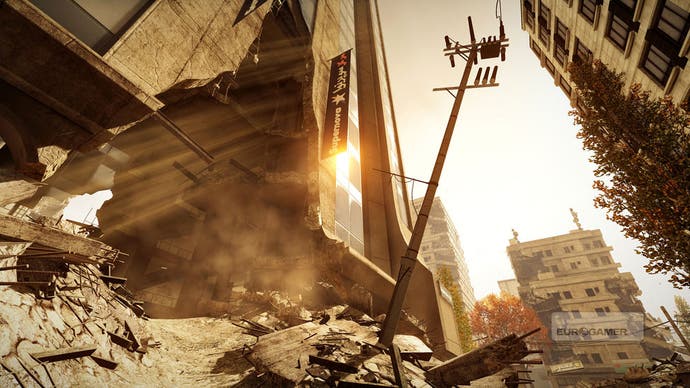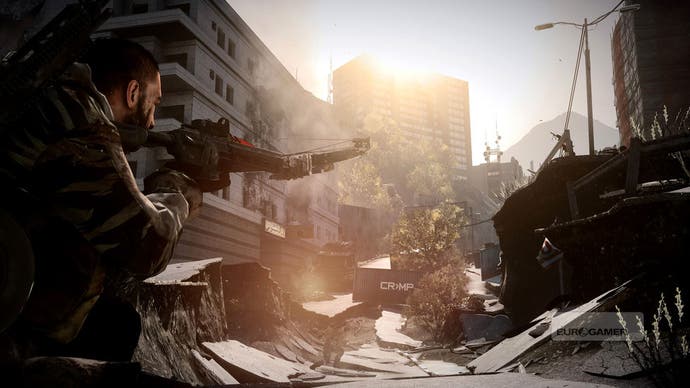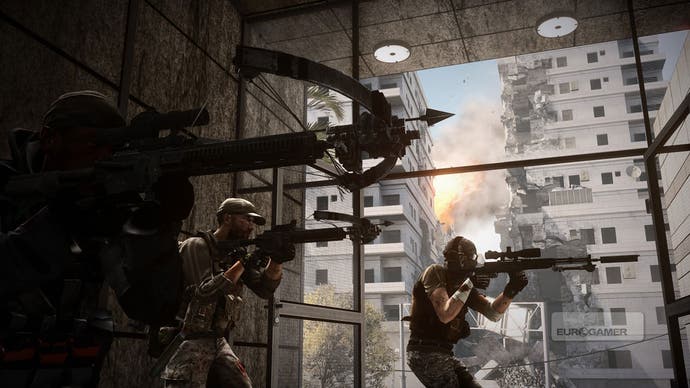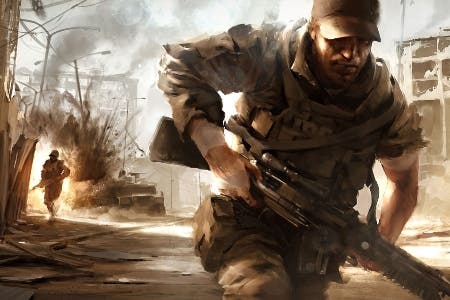Battlefield 3: Aftermath review
A barney in the rubble.
Most shooter map packs take a pick-and-mix approach, offering up a variety of layout types, locations and styles in order to make you feel better about handing over your money. DICE has been doing something different with Battlefield 3, however, by designing each add-on around a specific theme or gameplay style.
Back to Karkand was the retro pack, bringing popular maps of old into the new rotation. Close Quarters was a blatantly obvious two-finger salute to Call of Duty, ditching the epic scope expected from Battlefield maps and instead offering a tight, fast, headshot-centric experience. Armored Kill was all about the tanks, baby.
Aftermath is the most thematically focused yet, feeling like it should come in a cardboard box with a crinkly plastic window and the words “Tehran Earthquake Playset” emblazoned across the front. This is a collection of four maps all based around the devastating Iranian tremor that played an important role in the game's campaign mode - a bold idea, and one that is sometimes as limiting as it is inspired.
Epicentre, as the title suggests, is the core map of the pack, set at ground zero where the damage is at its worst. It's a city centre location with vast chasms in the main street creating skewed ramps and makeshift tunnels. Away from the central two-lane highway which cuts through the map, separating capture points with a no man's land gauntlet, there are alleyways and stairwells, courtyards and plazas. It's an absolute blast in Conquest mode as combat flows organically from all-out skirmishes to tense exploration, from high ground to low cover. Wherever you look, there's an alternate route that demands quick tactical thinking.

Also nudging the larger end of the map scale, Azadi Palace is my pick of the pack. Set across roughly one city block, it features perilous open streets, tangles of debris and - in the middle - a collapsing two-storey palace with a long open courtyard and broad sweeping staircases. It's an absolute gem of a map and a great example of DICE's expertise in crafting thrilling environments where the moment-by-moment narratives happen organically. Capture points are impeccably placed, each location holding a genuine tactical advantage but demanding bold strategies and no small amount of guile to approach. Whether you're prowling the exterior or bunkered down inside, this is a map that continues to reveal fresh routes, new tactics and wonderful surprises even after 10 or more matches in a row.
These large maps are where you'll make best use of the Rhino and Barsuk, the two new vehicles added for Aftermath. Customised civilian vans, their mangled bodywork both exposes passengers and allows them to return fire, while a roof-mounted gun provides the obligatory combat advantage. They're well suited to the Aftermath maps in terms of appearance and ability, but in a game already full of troop carriers and tanks they don't really add anything of value to the wider Battlefield 3 experience.
Talah Market is the most COD-like of the selection, a smaller, more rigidly defined arena where you're never more than a short sprint away from a contested zone. The density of the map offers lots of small ad hoc cover rather than large obvious safe spots, and it's not a location where hanging around is going to do you any favours. Get in, get moving and don't dawdle is the mantra here. What twists the market offers come from its pleasing loop of elevated positions, as access to the rooftops leads to a second tier of action. Gangplanks and some well-timed jumps will allow cunning players to get the drop on those scurrying around below, particularly if you're packing the new crossbow weapon. It's a fun toy, absolutely deadly in the right hands, but perhaps too much of a novelty to earn a full-time place in your loadout.
Markaz Monolith is the runt of the litter. It's not a bad map, but it's the most generic. Deep fissures in the streets offer both cover and pitfalls, but navigating their awkward slopes does the game engine no favours; suddenly getting stuck on a shallow incline because the geometry of the polygons doesn't match up is a mood-breaking reminder that you're in a digital world. The ruined multi-storey shopping mall at the heart of the map is the sole point of interest: a perilous rat run of tilting escalators and crumbling floors with an elevated pedestrian entryway providing both opportunity and threat depending on your situation.
"In a genre where sandblasted beige and brown textures have already become cliché, this is by far the beigest, brownest, most sandblasted collection of maps you're likely to see."

It's a serviceable enough FPS map, and would likely be a stand-out in any of the bandwagon-hopping military shooters trailing behind Battlefield and COD - but Azadi Palace takes the same basic idea and executes it with more style and scope, leaving this one a little surplus to requirements.
Aftermath definitely benefits from its cohesive nature and common theme of dust and collapse, so much so that sticking to a playlist of these maps generates a nice little meta-narrative all of its own. There may not be a post-earthquake story forced on you, but you'll make plenty of your own as you scramble around.
The theme can't help but make the maps feel samey, though. In a genre where sandblasted beige and brown textures have already become cliché, this is by far the beigest, brownest, most sandblasted collection of maps you're likely to see. Although each map has its own flourishes, the overall flavour of Aftermath is fairly uniform. It's also notable that the scenery destruction that has become Battlefield's hallmark is inevitably diminished in environments that arrive pre-ruined.
There are missed opportunities, too, in the new Scavenger game mode. Played on smaller variations of the maps, it's a ruthlessly fast-paced mash up of Team Deathmatch, Conquest Domination and Gun Game. You spawn with just a pistol and must scavenge for better weapons as you race from one capture point to the next, with flags being taken down and rising up at high speed.
It's breathlessly amusing, but utterly lacking in tactics or balance. There's no skill involved in improving your arsenal - all you need is the ability to spot bright blue arrows that indicate a weapon randomly floating in mid-air. It might be a level 1 SMG, it might be a level 3 rifle with a laser sight. You grab it and keep moving.

The fast pace keeps it fun, but there's no real thought to the scavenging mechanic and if it has any impact on the gameplay, it's to introduce an unwelcome imbalance. You're constantly aware that the player who just took you out with a sniper shot wasn't necessarily better than you, they were just lucky enough to come across a better weapon first. Spawn points are also chaotic. More than once, I respawned right in a contested area, literally next to an enemy. It keeps you on your toes, but there's none of the finesse and specialism that Battlefield excels at.
Where Scavenger does offer benefits is for those looking to boost their rank - this is a veritable cavalcade of XP opportunities, and in matches that can speed past in less than five minutes you'll capture dozens of flags and earn plenty of kills.
All of which makes this a tricky DLC beast to pin down for a score. If you're a common pleb who must wait and buy Aftermath separately, it's not so easy to recommend. Only two of the four maps feel truly essential, the new game mode is more a frantic doodle than a fleshed-out idea, while the new weapon and vehicles are of negligible use beyond the shattered confines of Aftermath's dusty arenas.
However, Epicentre and Azadi Palace are excellent maps that rank among the best on the now-sprawling Battlefield 3 playlists. They are superb illustrations of how few shooter developers understand how to create virtual space, and how to help players move through that space, as deftly as DICE. If you've already forked out for the Premium subscription, you'll find those maps justify this instalment on their own.

